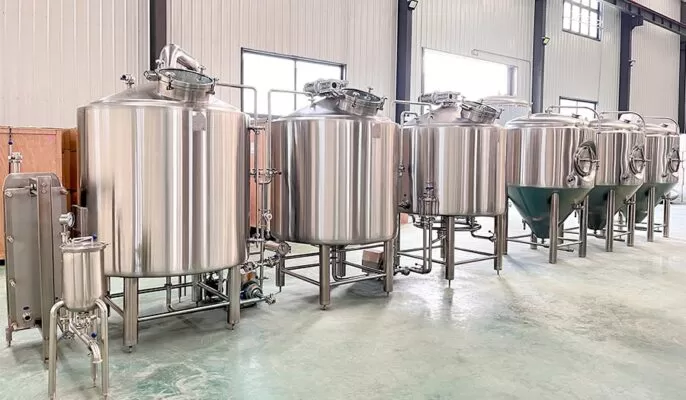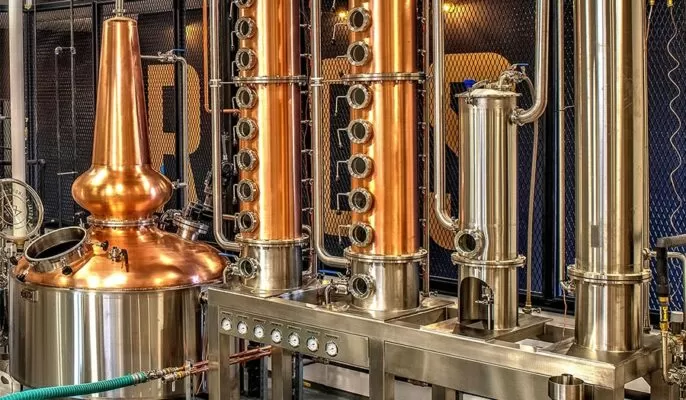Breweries and distilleries are both factories that produce alcoholic beverages, but they differ in the specific types of beverages they produce and the processes they use. Main ingredients is the first and most obvious answer. Beer and many alcoholic beverages (such as whiskey) are made from grains, while wine and similar beverages are made from grapes. But there’s more to these products than meets the eye, and it goes back to how they’re made. Alcoholic beverages are divided into three categories: brewing, distilling and brewing.
What is the difference between distilling and brewing?
The drinks produced are different
Breweries produce beer, a fermented beverage made from grains such as barley, wheat, or rye, as well as water, hops, and yeast. Beer production involves fermenting the sugars in grains to produce a beverage with a lower alcohol content.
Distilleries, produce distilled spirits, also known as liquor. Distilled spirits are produced by fermenting grains, fruits, or other materials to create a liquid with a higher alcohol content, and then using a process called distillation to separate the alcohol from the liquid, resulting in a more concentrated and stronger beverage. Examples of distilled spirits include whiskey, vodka, rum, gin, and tequila.

Different production processes
The production processes of breweries and wineries also differ. The brewing process followed by breweries involves mashing the grains to extract the sugars, boiling the liquid with hops to add flavor and bitterness, cooling and fermenting the liquid with yeast, and then carbonating and packaging the beer.
A distillery, but, follows a distillation process that involves fermenting grains, fruits, or other materials to produce a liquid, and then distilling the liquid in a copper still or other distillation device to separate the alcohol from the liquid. The alcohol vapor is then condensed and collected, creating a higher strength spirit. Distilled spirits are often aged in wooden barrels to develop flavor before being bottled and sold.
Alcohol content varies
Another major difference between a brewery and a distillery is the alcohol content of the drinks they produce. Beer ranges from 2% to 12% alcohol by volume (ABV), but some specialty beers may have higher ABVs. Distilled spirits, but, generally have a higher alcohol content, between 30% and 60% alcohol, although it can vary depending on the spirit type and aging process.
What steps in brewing are different from distilling?
Filter
Separates sugar from solids while reducing potential alcohol content. Next, the grains are rinsed according to a whole grain recipe, where the brewer/distiller mashes the grains. This is a brewing-specific step where you want to reduce the potential alcohol content to around 5%. But, when making whiskey you want the potential alcohol content to be as high as possible, so this step can be skipped.
Boiling
This step is unique to home brewing, but can be done even if you don’t use an all-grain recipe. Boiling extracts flavors from other ingredients such as hops, removes proteins that cause cold haze, and various other reasons why it is unsuitable for whiskey production.
Fermentation
Now we’re going to go back to the distillation process, which is how alcohol is made. Making the alcohol first is necessary because distillation is a method of separating compounds by boiling them, then condensing and collecting only the compounds we want.
Fermentation is used to do this. Except for whole grain whiskey (or whole grain vodka), most distilling recipes start with fermentation.
Whether you brew beer or distill spirits, most problems occur during the fermentation process. Fermentation, especially that of beer or whiskey, requires extreme vigilance to prevent infection that could ruin the entire batch. Regardless of intended use, sterilize all tools and equipment used to mix materials to ensure safety.
Distillation
Instead of bottling the beer or wine, transfer the fermenting liquid to a still. Although this is optional, it is usually recommended to clarify the liquid before distilling to avoid scorching any remaining solids or yeast.

Reflux distillation
Reflux distillation is the most popular method among newer stills. Like kit brewing, it’s the easiest to learn and master, allowing you to become familiar with the entire process. Reflux is most used in the distillation of neutral spirits (vodka), some rums and gins in more advanced procedures and equipment.
Pot distillation
While this method may seem easier than reflux distillation at first glance, it can be more complex and sensitive than reflux and requires more practice to get an optimal product. But, enthusiasts who want to be more involved in the process, such as home brewing, often choose pot distilling. This method of distillation is most used for flavored spirits such as whiskey, brandy, gin, etc. It requires control over which parts of the distillate are collected or discarded based on temperature, odor, taste and experience.
How is distillation equipment different from brewing equipment?
Brewing and distilling must different tools. The first stage of the brewing process requires coarse grinding; thus, the husks remain intact. So, the space between the rollers in the mill will become wider. Usually at least a two-roller mill is used. Four-roll mills are often used to get a finer grind and more consistent results.
The best grinder for distillation is a four-roller grinder, which is most common during the threshing process. Four-roll mills are ideal for grinding harder grains (such as wheat, rye, and unmalted corn) into finer grains (which are needed during the distillation process). A six-roller mill, eight-roller mill or even a hammer mill is recommended for the finest and most consistent grinding throughout the grain fermentation process.




